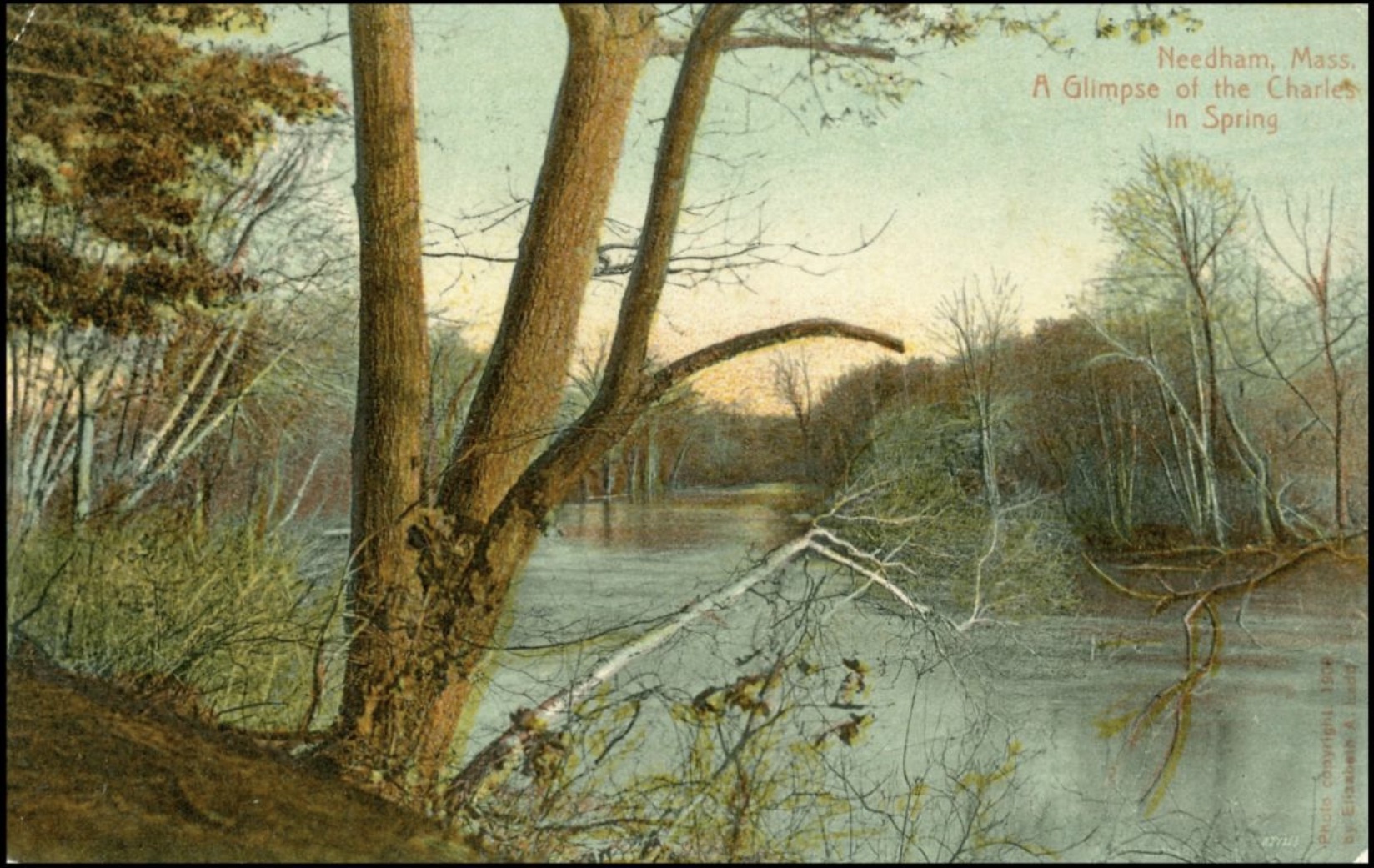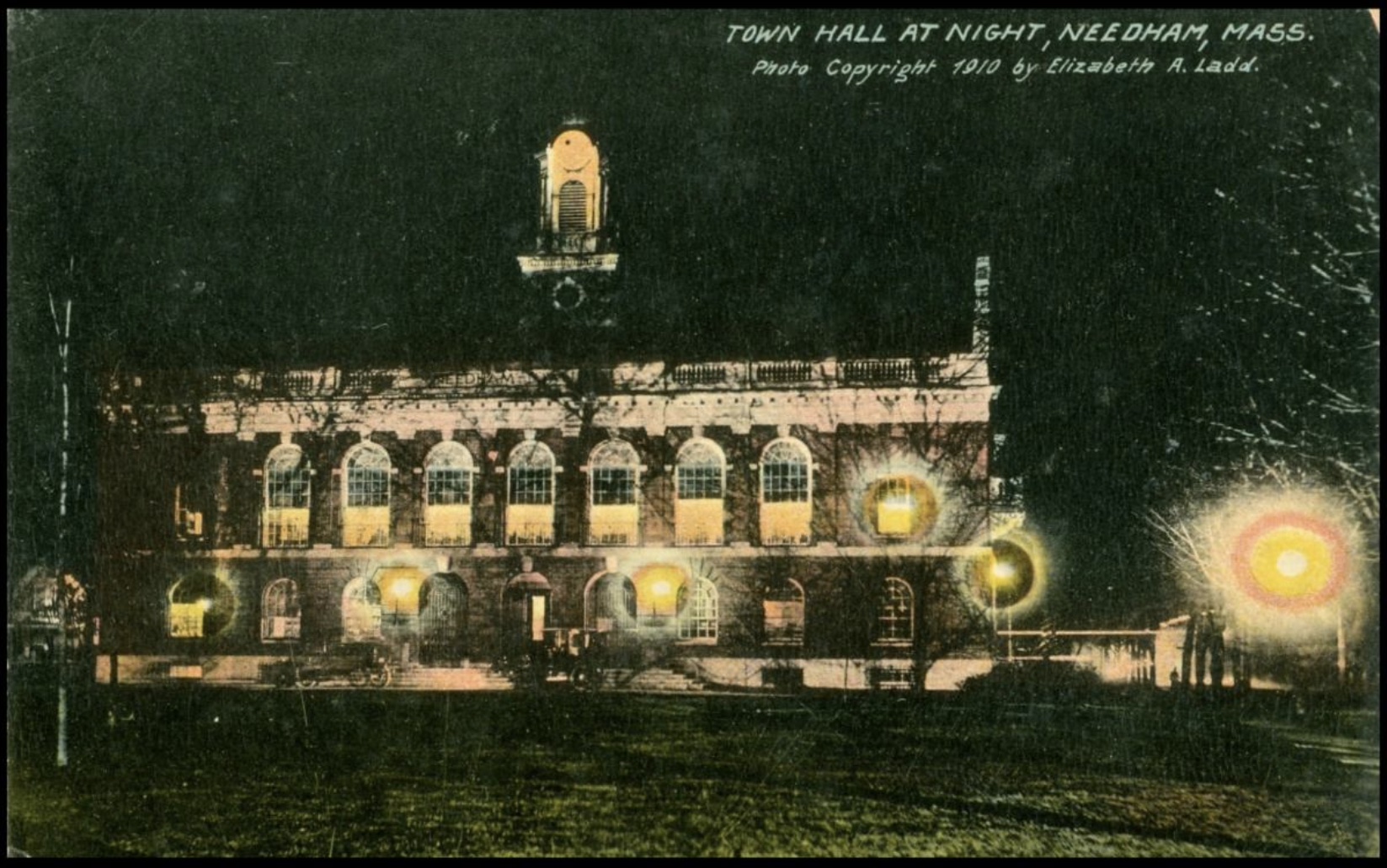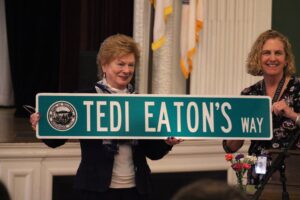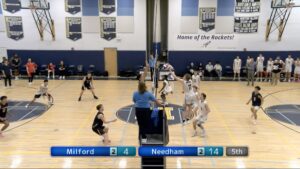
Needham History: “Photograph Copyright by Elizabeth A. Ladd”
A brief career – so far as we know. Maybe not?

” ‘A Glimpse of the Charles River in Spring,’ Photo Copyright 1908 by Elizabeth A. Ladd.” All of Ladd’s postcards have her copyright imprint along the margin (in this case, the lower right corner).
“Photograph Copyright by Elizabeth A. Ladd”
Does anyone actually send postcards anymore? Time was (and I remember it well) that you could not go on a trip without the obligation of sending postcards home. One of your first tasks on arrival in Foreign Parts was to buy postcards, and stamps, and then find a café where you could sit and write them all. They had to arrive home before you did. Even on a short trip, you did not DARE not send a card to your grandmothers.
Postcards are still widely available in places where there is some tourism. Some of them may even get sent, though I suspect most people are like me and buy them for themselves, because there is no other way to get a picture of an aerial view, or a sunny day in London, or Venice without the crowds.
Apart from their tourist appeal, picture postcards became popular in the late 19th century as an inexpensive way to send a message. The legislation to create Mailing Cards dates to 1861, but for the first few decades the cards were mostly blank cards with the government imprint, and could be mailed for a penny. Private publishers could also make mailing cards, but the cost to send those was double – two cents.
In 1898, the cost for all cards was reduced to one penny, and publishers had more incentive to produce and market their own cards. To make them more attractive, the cards could be printed with pictures on one side. The entire second side was reserved for the recipient address (“undivided back cards”), so any message had to be squeezed into the margins of the picture side. In 1907, this rule was relaxed, and the back was divided into a message section and an address section, the way we are used to today (“divided back cards”).
The divided back ushered in a Golden Age of postcards – the space was more useful for sending messages, and the attractive picture could take up the whole front. Two other innovations added to the popularity of the cards. One was the use of color –black-and- white images were sent to Germany and colorized. Germany at the time had the most sophisticated color lithography expertise, and dominated the market in color postcard printing. The second innovation was postcard-format cameras; for example, the Kodak had “postcard camera” (1903) took negatives in postcard format that could be printed directly onto divided back card stock.
This Golden Age ended in 1915. War in Europe and enmity with Germany ended the transatlantic commerce in postcard printing. American printers found new ways to produce color postcards, but they were not as fine as the German ones. The Smithsonian has a good summary of postcard history.
Although we associate postcards with places that get lots of tourists, penny postcards at the turn of the century were abundant and popular, even in small towns like Needham. Both the card and the stamp were inexpensive, so postcards became the preferred means of sending a quick note, like “I’ve arrived safely” or “I will be home tomorrow on the 2 o’clock train.” There are literally dozens of Needham postcards from the first half of the 20th century, including early undivided-back cards, divided-back lithograph cards, and later types. Many of the merchants in town commissioned their own cards to sell, so the cards bear the imprints of John L. Twigg (druggists), Charles Childs (dry goods and clothing), Maloney & White (druggists), and Virgil Rowe (druggists).
“Town Hall at Night,” a rare nighttime exposure, 1910.

For the most part, we don’t know who took the photographs. With one exception. For a brief period, 1908 to 1910, some of the best lithograph postcards bear the inscription, “Photograph Copyright by Elizabeth A. Ladd.”
There is not much information about Elizabeth Ladd, and I might never had heard her name if it were not for the postcards. Elizabeth Appleton Ladd, known as Lizzie, was the oldest child of Levi Ladd and Elizabeth Appleton. She was born on 26 February 1860. Her mother was a member of the wealthy Appleton family of Cambridge, and a relative by marriage to Henry Wadsworth Longfellow. Levi Ladd owned farmland on South Street. He was also a real estate agent and property developer, and created and sold house lots in the area around Great Plain Avenue and Warren Street. He was an officer in numerous civic clubs, and served the town as Assessor for many years.
Levi’s youngest daughter, Martha, married Charles P. Holmes. Charles, and his brothers Oscar and N(ahum) Harry were carpenters and house builders. They built many of the houses on the lots that Levi Ladd developed. But in addition to their house-building career, the Holmes Brothers were well-known photographers. Their studio was in Charlestown, but they lived in Needham nearby the Ladd’s farm (which is how, I assume, Charles met Martha). They also did a great deal of photography of Needham scenes (including the nifty habit of photographing the houses that they built).
I am assuming that Lizzie came by her photography expertise through her Holmes brothers-in-law; at any rate, this is the closest connection that I can find and makes the most sense. Her postcard images are tightly dated, from 1908 to 1910. She also made a few postcards in other towns, especially Westwood. In all, I have been able to find 25 different postcard images by Lizzie Ladd for this period, 21 of Needham scenes. My very favorite is one that she took of Town Hall at night – the windows lit up and the long exposure turning the street lamps into luminous orbs.
Like the other Needham postcards, the Ladd cards were sold through a local store – in this case, Ladd Brothers, Real Estate and Insurance. The Ladd Brothers were Lizzie’s two brothers Samuel and John, who took over the business from their father Levi. For the first two years, her cards bear the imprint of “J.L. Ladd.” In 1910, however, the publisher imprint is E.A. Ladd – Lizzie herself.
That’s all That’s where my information runs out. I do not know why Lizzie started taking photos, nor why she stopped after two years. Of even if she did stop. We have no way of knowing whether any of our other Needham photos were taken by her, but not identified. I am kind of surprised that we know as much as we do.
A few of the Ladd postcards are included here. Several more are posted with this story in the Weekly Stories archive on our website.
“Express to Boston, passing under the Greendale Avenue Bridge,” 1908.

 |
Gloria Polizzotti Greis is the Executive Director of the Needham History Center & Museum. For more information, please see their website at www.needhamhistory.org. |

